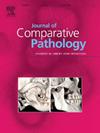猫的硬化性嗜酸性肝外胆管炎
IF 0.8
4区 农林科学
Q4 PATHOLOGY
引用次数: 0
摘要
一只9岁的母猫被送到兽医院,有进行性体重减轻、厌食症和黄疸的病史。临床表现包括身体状况不佳、体温过低和黄疸。超声检查结果与胰腺炎相关胆管性肝炎一致,生化检查显示肝胆酶(碱性磷酸酶、丙氨酸转氨酶、γ -谷氨酰转肽酶)活性明显增加。尸检发现,该动物的粘膜和皮下组织有明显的黄疸,肝脏轻度增大,呈弥漫性橙色变色。囊管增厚,白色,坚硬,完全阻塞。胆囊肿大,胆汁增厚。镜下,囊管被纤维结缔组织的严重增生和胆管的明显增生所覆盖,可见明显的多灶性炎症细胞浸润,主要由嗜酸性粒细胞、淋巴细胞、罕见的浆细胞和巨噬细胞组成。尽管嗜酸性胆管炎在人类中被认为是良性的,但在本病例中,由于嗜酸性炎症和纤维结缔组织增生导致囊管壁增厚,导致囊管完全阻塞,导致临床恶化。本文章由计算机程序翻译,如有差异,请以英文原文为准。
Sclerosing eosinophilic extrahepatic cholangitis in a cat
A 9-year-old female cat was presented to the veterinary hospital with a history of progressive weight loss, anorexia and jaundice. Clinical findings included poor body condition, hypothermia and jaundice. The ultrasound findings were consistent with cholangiohepatitis associated with pancreatitis and the biochemical tests indicated a marked increase in activities of hepatobiliary enzymes (alkaline phosphatase, alanine aminotransferase, gamma-glutamyl transpeptidase). At necropsy, the animal had marked jaundice in the mucous membranes and subcutaneous tissue and a mildly enlarged liver with diffusely orange discolouration. The cystic duct was thickened, white, firm and completely obstructed. The gallbladder was enlarged and contained thickened bile. Microscopically, the cystic duct was obliterated by severe proliferation of fibrous connective tissue and marked proliferation of bile ducts, with a prominent multifocal inflammatory cell infiltrate composed predominantly of eosinophils, lymphocytes, rare plasma cells and macrophages. Although eosinophilic cholangitis is considered benign in humans, in this case it had led to complete obstruction of the cystic duct due to wall thickening caused by eosinophilic inflammation and fibrous connective tissue proliferation, which contributed to clinical deterioration.
求助全文
通过发布文献求助,成功后即可免费获取论文全文。
去求助
来源期刊
CiteScore
1.60
自引率
0.00%
发文量
208
审稿时长
50 days
期刊介绍:
The Journal of Comparative Pathology is an International, English language, peer-reviewed journal which publishes full length articles, short papers and review articles of high scientific quality on all aspects of the pathology of the diseases of domesticated and other vertebrate animals.
Articles on human diseases are also included if they present features of special interest when viewed against the general background of vertebrate pathology.

 求助内容:
求助内容: 应助结果提醒方式:
应助结果提醒方式:


